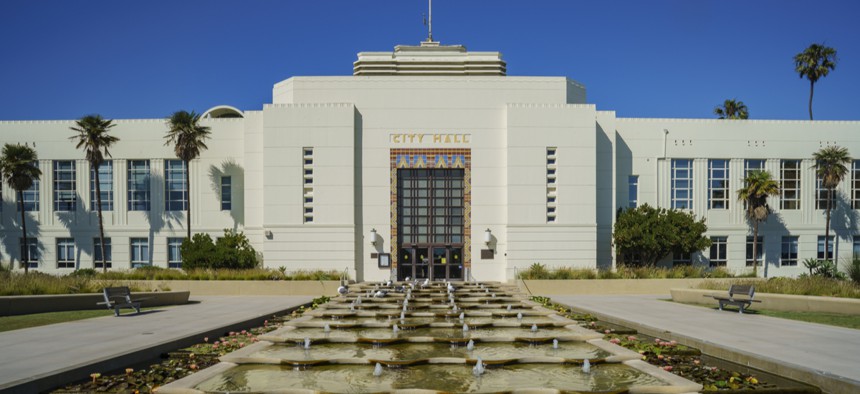In Santa Monica, City Hall Makes its Own Water, Power—and Goodwill

Santa Monica City Hall. A portion of the facility has been renovated to be one of the most energy efficient buildings in the region. SHUTTERSTOCK/KIT LEONG

Connecting state and local government leaders
COMMENTARY | Municipal leaders can build new facilities that recycle water and generate power, as well as uplift staff and citizens.
Municipal and state buildings serve valuable public purposes, but they also consume huge amounts of energy and water resources. According to the United Nations Environment Program, public and private sector buildings account for 36% of global energy use and 39% of related carbon dioxide emissions annually. Large commercial buildings of greater than 200,000 square feet also use more than 360 billion gallons of water annually.
But some municipalities are showing how to stop just using resources and turn their buildings into net resource producers.
That’s the untold story behind a sleek new city hall facility built by the Santa Monica city government that speaks to 21st-century city governance with its transparent, open design and its super-efficient, low-cost building systems. The facility is equipped with rooftop solar panels that shed rainwater to collectors for purification, storage and later reuse, a feature which no other government building in the region can claim and is among the first for any municipality in the world.

Water recycling is one of many strategies that the International Living Future Institute (IFLI) indicates through its Living Building Challenge as one of the key drivers in achieving net-zero energy and water use. The Living Building Challenge is an international sustainability standard that outlines performance measures so that buildings are self-sufficient and produce as much energy and water as they consume. This certification aligns directly with long-range sustainability commitments made by the Santa Monica City Council to achieve community-wide carbon neutrality by 2050 or sooner.
But building such a facility was no easy task and public leaders faced a number of daunting hurdles. The City of Santa Monica team, including the city’s construction manager Tim Purcell and chief sustainability officer Shannon Parry, had to work around outdated attitudes and get people to embrace new, innovative solutions to ensure the construction was appropriately scaled, elegant and efficient. Similarly, the designers had to find ways to work in concert with code conformance, legal requirements and land use regulations. For example, to meet water-use goals, the project team prepared for 30 meetings with agencies from city, county, state and federal jurisdictions. This meant the designs had to constantly evolve with creative solutions that met schedule and budget requirements, while also limiting the risk associated with any nontraditional materials or methods.
Finally, after overcoming these hurdles, Santa Monica officials debuted its City Hall East building this year on Earth Day, with a virtual tour led by the U.S. Green Building Council nearly six years after the team embarked on the 50,000-square-foot project. This new structure is now part of the municipal campus and sits alongside the historic 1939 City Hall building.
While the beautiful downtown facility turns heads, city officials also commended its smarts and its signal achievement: becoming the first-ever municipal project to create zero waste and to produce all the water and energy it will ever need.
Now under evaluation by the ILFI certifying body for the next 18 months, Santa Monica’s new City Hall East is tracking to become the first municipal facility to meet the Living Building Challenge—a unique distinction but one that will serve every citizen of Santa Monica for decades to come.
It just goes to show that America’s best cities can lead by example even during this time of national crisis.
Heidi Creighton is an Associate Principal at Buro Happold and she is a registered architect, a LEED Fellow, WELL Faculty, and a Fitwel Ambassador. Her work focuses on sustainability as well as health and wellbeing strategies for academic, healthcare, commercial, and residential projects.

NEXT STORY: US-made small drones added to GSA schedule




